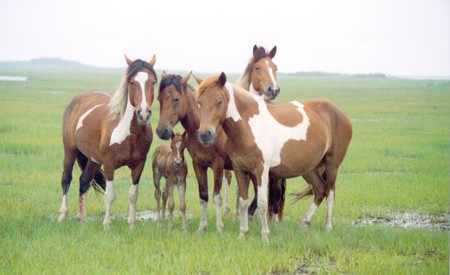Unbridled feral ponies and herds of elk still roam free east of the Mississippi. These herds represent what remains wild, what we haven’t destroyed or tamed. Watching a pony run across pristine white sand beaches or an elk feed in a lovely mountain meadow stirs something deep within.
But the real allure of herds is what they teach us about belonging. Watching the elk and ponies eat, sleep, and roam together reminds us of how fragmented our own lives have become. The elk and ponies remind us of a forgotten freedom, that which comes from the sacred connection to something greater than ourselves.
To catch a glimpse, gather your own herd and head to Elk County in Pennsylvania, Assateague National Seashore in Maryland, Grayson Highlands State Park in Virginia, or Cataloochee Valley in Tennessee.
Elk
Elk once lived in wooded areas throughout the eastern United States. Overhunting and habitat loss nearly wiped them out entirely. In recent years, reintroduction programs have relocated elk to the Great Smoky Mountains National Park and to areas in central Pennsylvania.
Catch them early morning and late evening when they feed on grasses in open meadows. One of the best times of year to view the elk is September and early October when the rut occurs. Dominant bulls breed with harems of up to 20 cows. Males demonstrate ritualized mating behavior, including a distinct bugling sound that can be heard from a mile away. Large bulls also use their antlers to spar with other males.
Elk are bigger than black bears and usually quite docile. If provoked, however, elk will charge at people. The general rule is to give an elk at least 150 feet of space. But any distance that disrupts an elk’s natural behaviors is too close.
Cataloochee Valley, Great Smoky Mountains National Park
Rugged mountain peaks tower above the fertile Cataloochee Valley. In the early 1900s, over a thousand farmers lived there. Now, over 140 elk feed in the open meadows and meander among the historic buildings recreated by the park service and homesites of long ago.
The Park Service relocated 25 elk in 2001 from the Land Between the Lakes National Recreation Area along the Tennessee-Kentucky border. Besides elk, other wildlife viewing opportunities include bear, deer, and turkey.
While in Cataloochee Valley, hike the seven-mile Boogerman trail. The trail was named after Robert “Boogerman” Palmer, and you’ll see his homesite, along with several others, from the trail. The trail also traverses old-growth forests and mountain streams.
Elk County, Pennsylvania
In the heart of Pennsylvania’s most wild and rugged country, one of the largest elk herds in the Eastern U.S. roams freely. The elk that originally inhabited Pennsylvania were hunted to extinction, and the elk there today were transplanted from the Rocky Mountains.
Seeing a 700-pound bull elk alongside a country road or even in a local resident’s backyard isn’t uncommon in the small community of Benezette. The 127-mile Elk Scenic Drive also has designated elk-viewing areas and the Elk County Visitor Center teaches visitors about conservation efforts. The Elk Trail was designed to provide backpackers with plenty of opportunities to view Pennsylvania’s wild elk herds.
Wild Ponies
The “wild ponies” that frolic on beaches and parade along mile-high ridgelines are neither ponies nor wild. Actually, they are feral animals, meaning that they are descendants of domestic animals that have reverted to a wild state.
Many believe these wild ponies should be removed, especially from barrier islands like Assateague and Cumberland. Some of the horses on Georgia’s Cumberland Island suffer from malnutrition, disease, and worms because horses are not native to the island ecosystems and aren’t suited for the island’s harsh environment. They also compete with native species for the island’s limited resources. The horses regularly chomp on marsh grasses, which provide water filtration and serves as a nursery for many shellfish. Horses also regularly graze on sea oats, which literally hold the dunes together.
But for many tourists, the “wild” horses are part of the allure of Assateague and other barrier islands. They argue that the impact of the horses is insignificant, and on Assateague, the annual Pony Penny Festival is used to cull the herd and keep their numbers manageable.
Just because the horses were once domesticated doesn’t mean that they are tame. All too often, tourists feed and pet the horses. The horses will get remarkably close to visitors, and appear to be curious and friendly, but they often bite and kick. Not only do horses get sick from human food, but the lure of junk food also brings the horses close to the road where they poke their heads into cars looking for a snack. Many horses have died on Assateague Island from collisions with vehicles.
Assateague Island National Seashore, Va./Md.
How the horses got to Assateague remains a mystery, but most likely they are descendents of horses brought over in the 1600s by farmers trying to avoid paying taxes on livestock, and some horses wandered off to form a feral herd.
The horses have free reign of the thirty-seven miles of pristine white sand beaches of the barrier island, as well as the sand dunes and marsh lands. Observers often comment on the barrel-like bellies of the horses, a result of their high-salt diet. The cold winters result in thickening of their coats, and the scorching summer sun streaks their manes’ golden hues.
The ponies roam the island’s Virginia half and the Maryland half, separated only by a fence. The National Park Service manages the Maryland herd, while the Chincoteague Volunteer Fire Company claims responsibility for the Virginia herd. Park officials have instituted rules requiring visitors to secure food and trash and to remain at least ten feet away from horses. Tourists who ignore the rule can be fined $100.
Plan a two-car shuttle and paddle on the Chincoteague Bay side of Assateague. Twenty-five miles of flat water paddling is easily doable during a two-day trip. Camping among the pine trees is an option at the four canoe-in campsites on the Maryland side. Each site has a chemical toilet and a picnic table, but there is no drinking water on the island, so plan accordingly.
Grayson Highlands State Park, Va.
It wasn’t until 1975 that 50 hardy Assateague ponies were released in Virginia’s Grayson Highlands to graze the balds and keep the brush in check. Before logging and ranching took place in the mountains, the Highland’s balds were heavily forested. Extensive logging in the late 1800s cleared the woods. When the last tree had been cut down, cattle ranchers flocked to the area and their cows kept the balds clear. The cows left in the early 1900s, and the brush overtook the once-cleared land. Today, the wild horses are responsible for maintaining the well-manicured balds.
The horses resemble a slightly larger and more weathered version of a Shetland pony. In the warmer months, the wild ponies stay up in the higher elevation, where it’s better picking. That helps manage the threat of fire on the mountains’ grassy bald faces. In the cooler months, the horses go to the wetlands at lower elevations, where the elements aren’t as harsh.
Part of ensuring that the herds are healthy involves a twice a year roundup, at which time the Wilburn Ridge Pony Association provides veterinary assistance to injured horses. They also provide the horses with salt licks and feed during particularly lean winters. They hold an annual auction every September. All the auctioned ponies have passed veterinary examinations and testing, and the proceeds go toward sustaining the herd.
While visiting Grayson Highlands, lace up your boots and check out the eleven-mile AT and Pine Mountain Loop Trail, featuring bald mountains with expansive vistas and wild horses. Or backpack into Campsite #1 and bag Mount Rogers, the tallest peak in Virginia.








